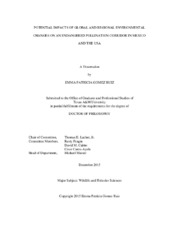| dc.contributor.advisor | Lacher, Thomas E. | |
| dc.creator | Gomez Ruiz, Emma Patricia | |
| dc.date.accessioned | 2016-05-04T13:19:23Z | |
| dc.date.available | 2019-12-01T06:33:43Z | |
| dc.date.created | 2015-12 | |
| dc.date.issued | 2015-08-21 | |
| dc.date.submitted | December 2015 | |
| dc.identifier.uri | https://hdl.handle.net/1969.1/156381 | |
| dc.description.abstract | Maintaining migratory corridors that allow winged pollinators to move and transport pollen is critical for preserving the genetic diversity of plant species and, as a result maintains the resilience of the ecosystem to changes in the environment. Migratory pollinators require a tight synchrony between the timing of their migration and the peak nectar availability of flowering plants along the corridors they travel. This synchrony can easily be disrupted by climate change or by human-induced land cover change. Pollinating bats are large-bodied and can carry large pollen loads between distant populations of plants. Plants of the genus Agave subgenus Agave have evolved particular flower characteristics to attract bats. The nectar-feeding Mexican long-nosed bat (Leptonycteris nivalis) relies on the presence of flowering Agave spp. for its migration from central Mexico to the southwestern United States. L. nivalis is listed as endangered by the United States, Mexico and the International Union for the Conservation of Nature, due to declines in its populations of over 50% in the past ten years.
I conducted three studies to address important ecological questions related to the Agave-L. nivalis corridor. First, I used species distribution modeling algorithms to generate potential distributions of the Agave species that occur in the corridor. I created a map of Agave richness and analyized the correspondence of different levels of richness with the known areas of presence of L. nivalis. The results indicate a relationship between occurrence of L. nivalis and areas with two or more Agave species and highlights areas along the mountain chains as the stepping-stones of the corridor. Second, I modeled the potential distribution of the Agave species and L. nivalis under future climate scenarios for 2050 and 2070. The models indicate a significant reduction in the overlap of Agave spp. and L. nivalis. Lastly, I analyzed the effects of three decades of land cover change on Agave habitat. The results show that the fragmentation trend in agave habitat has slowed down from 1985 to 2011. However, even under scenarios of no further habitat loss, climate change will continue to have impacts on this plant-pollinator interaction. | en |
| dc.format.mimetype | application/pdf | |
| dc.language.iso | en | |
| dc.subject | pollination corridor | en |
| dc.subject | nectarivorous bats | en |
| dc.subject | Leptonycteris nivalis | en |
| dc.subject | Agave | en |
| dc.subject | species distribution models | en |
| dc.subject | GARP | en |
| dc.subject | Maxent | en |
| dc.title | Potential Impacts of Global and Regional Environmental Changes on an Endangered Pollination Corridor in Mexico and the USA | en |
| dc.type | Thesis | en |
| thesis.degree.department | Wildlife and Fisheries Sciences | en |
| thesis.degree.discipline | Wildlife and Fisheries Sciences | en |
| thesis.degree.grantor | Texas A & M University | en |
| thesis.degree.name | Doctor of Philosophy | en |
| thesis.degree.level | Doctoral | en |
| dc.contributor.committeeMember | Feagin, Rusty | |
| dc.contributor.committeeMember | Cairns, David M. | |
| dc.contributor.committeeMember | Cantu-Ayala, Cesar | |
| dc.type.material | text | en |
| dc.date.updated | 2016-05-04T13:19:23Z | |
| local.embargo.terms | 2019-12-01 | |
| local.etdauthor.orcid | 0000-0001-7423-8925 | |


